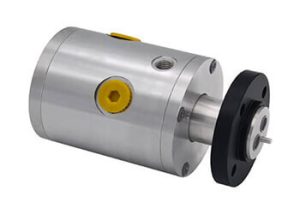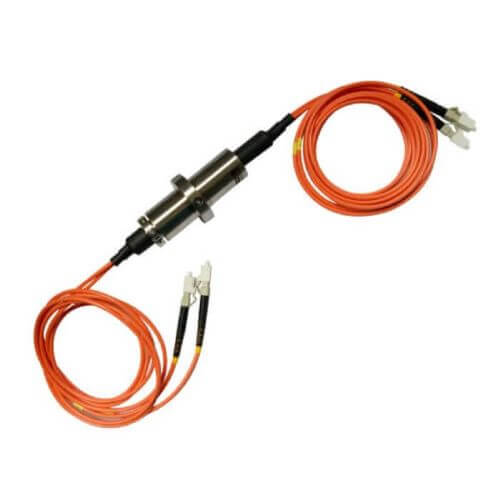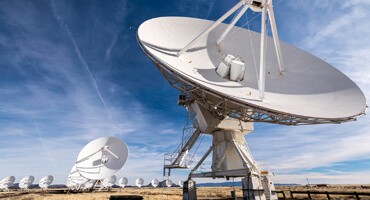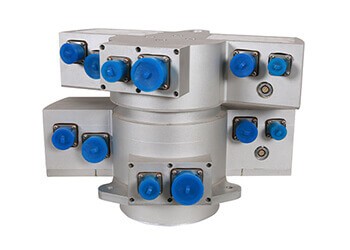Slip rings play a vital role in modern military and aerospace systems, enabling constant electrical connections in rotating scenarios. This comprehensive guide aims to deepen the understanding of the application of slip rings in military and aerospace contexts, shining light on their significance in today’s technologically advanced era.
Slip Ring Basics
Before delving into specific applications, it’s essential to understand what a slip ring is and the different types available, each with its unique capabilities and advantages.

Definition and Working
A slip ring, also known as a rotary electrical interface, rotating electrical connector, or electrical rotary joint, is designed to maintain a continuous electrical connection between stationary and rotating parts of a system. The main constituents of a slip ring are its stationary and rotating members (stator and rotor). The stator is typically connected to the static part of the system and houses the brush contacts, while the rotor, linked to the rotating part, carries the ring.
Operating on a basic principle, the brush contacts slide on the rotating ring surface when the equipment spins, assuming the function of an electrical conduit. The resulting friction between the brush and the ring creates an electrical pathway, permitting energy and signal transfer across the rotating interface.
Slip rings can carry multiple types of signals such as power, data, or even video signals. The materials used in making the brush and ring vary with the type of slip ring and its intended use. Commonly used materials include precious metals, copper alloys, or graphite, primarily chosen for their high conductive and low-resistant traits.
Their construction can be as simple as a single metal ring and a brush, to more complicated multiplex systems with several rings and brushes. This variability allows them to be used in a multitude of applications, from simple rotating displays to sophisticated military and aerospace systems. Crucially, slip rings enable the rotation of an object without obstructing or tangling the connection cables, thereby ensuring a seamless and steady transmission of power and signals.
In Military grade slip ring anti-interference design, slip rings also incorporate technologies such as fiber optics or RF rotary joints to facilitate high-speed data transmission, thus making them ideal for complex communication systems that require high data transfer rates, such as those found in military radar systems or satellite communication devices.
Different Types and Their Advantages
There are myriad slip ring types and variants, each designed to meet specific use cases and system requirements. Here’s a deep dive into some of the key types and their advantages:
- Conductive Slip Rings
These are the most traditional type of slip ring. They primarily use physical contacts through metal brushes and rings for signal and power transmission. The key advantage of conductive slip rings is their cost-effectiveness. They are often less expensive and find use in a wide range of applications. However, they may require regular maintenance due to wear and tear of the physical contacts.
- Fiber Optic Slip Rings (FORJs)

As the name suggests, these slip rings use fiber optics for signal transmission. These are ideal for high-speed data and signal transfer due to their high bandwidth capacity. Apart from that, they are immune to electromagnetic interference, which ensures high-quality signal transmission. This type finds utility in sophisticated systems requiring high data speed, such as radar and satellite communication systems.
- Wireless or Capacitive Slip Rings
These are cutting-edge slip rings that use wireless or capacitive coupling for signal transmission, eliminating the need for physical contact between components. This results in less wear and tear, contributing to their longer lifespan and reduced maintenance requirements. They are best suited for systems where uninterrupted long-term performance is critical, such as in industrial automation or wind turbines.
- Pancake or Flat Slip Rings

These slip rings are designed with a flat disc-like appearance and are apt for systems with space constraints. Even though their compact size can impact their performance relative to traditional cylindrical slip rings, their compatibility with tight spaces makes them desirable for particular applications.
- Mercury-Wetted Slip Rings
These slip rings use liquid mercury for making connections. Mercury, being an excellent conductor, provides low-resistance signal pathways. These rings offer advantages such as low noise and minimal maintenance, but they are not as common due to the highly toxic nature of mercury and the associated safety concerns.
Picking the right type of slip ring involves understanding the specific requirements of the application, including factors like the required electrical load, signal types, environmental conditions, available space, lifespan, and maintenance considerations. With an array of options available, technology has indeed opened pathways for optimization, further contributing to the advancement in the sectors of military and aerospace.
Slip Ring Applications in Military and Aerospace
This main section discusses the vital utility of slip rings in the military and aerospace sectors, illustrating their key roles in different subsystems and equipment.
Military Applications
In the military sector, Military Slip Ring play an integral role in ensuring the seamless operation of various devices and systems. The demand for robust and reliable equipment in this sector underscores the need for high-quality slip rings. Let’s delve into their key applications:

- Radar Systems

Radar systems, central to military surveillance and tracking operations, require continuous rotation of antennas to scan environments. Slip rings in these scenarios facilitate the necessary electrical connections, sustaining power supply and data transmission while the antennas rotate. Their reliability and efficiency contribute to the accurate functioning of radar systems, making them indispensable in this context.
- Weapon Systems
Firepower delivery systems, such as the turrets on tanks and mobile artillery units, often need to rotate 360 degrees to aim accurately. Slip rings are key to maintaining uninterrupted communication and power transfer amidst this rotation, enabling weapon systems to operate effectively.
- Unmanned Aerial Vehicles (UAVs)
Modern warfare often employs drones or UAVs for surveillance, targeting, and reconnaissance missions. These drones have rotating parts, like the camera gimbals, requiring smooth transmission of power and data. Slip rings ensure such seamless connections, enhancing the capabilities of these drones.
- Robotic Systems

Advanced militaries are increasingly leveraging robotic technology for various applications, from bomb disposal to logistics. Robotic systems often involve rotating units that are powered and controlled through slip rings, aiding in their efficient operation.
- Military Grade Computers and Displays
Devices like onboard computers and display systems used in military applications often have rotating parts. Slip rings facilitate the necessary power and signal transmissions in these applications, ensuring the devices function efficiently even in challenging environments.
Choosing the right slip ring for these applications involves considerations around environmental conditions, required data transfer rates, load capacity, and reliability. The increasing sophistication of military technologies continues to drive demand for equally advanced slip ring solutions.
Aerospace Applications
Slip rings have a profound impact on aerospace applications, particularly in systems requiring power transmission and data communication between stationary and rotating components. Here’s a deeper insight into their essential applications in the aerospace sector:
- Satellites
Satellites often use slip rings in their solar panel assemblies, which constantly rotate to face the sun and maintain optimal energy generation. Slip rings are critical in transferring generated power from the solar panels to the satellite’s main body without limiting the movement of the panel assembly. Fiber optic slip rings are also utilized in satellites for high-speed data communication.
- Spacecraft
Spacecraft rely on slip rings when they require rotation or movement in systems like docking rings, robotic arms, or antenna arrays. Slip rings enable smooth and continuous power transmission and communication without hampering these movements, ensuring the proper functioning of the various systems.
- Launch Vehicles
Launch vehicles (rockets) can also benefit from slip rings, particularly during stage separation and payload deployment. The slip rings in these scenarios facilitate constant communication and power transfer between the inter-stage components and the payloads being deployed, ensuring accurate guidance and deployment.
- Avionics Components
Avionics systems, the electronic components that support the operation and control of aircraft, often rely on slip rings. Examples include rotating radar antennas, navigation systems, and aircraft-mounted cameras that need uninterrupted power and signal transmission during rotation. Additionally, rotary slip rings can be found in flight control system actuators, ensuring smooth control surface movement.
- Aircraft Engines
Certain aircraft designs, such as helicopters and tiltrotor aircraft, require the transfer of electrical signals and power between the stationary and rotating sections of their engines. Slip rings to aid in achieving this, allowing for the seamless control and monitoring of engine performance during operation.
In the aerospace sector, choosing slip rings involves stringent requirements such as high reliability, low maintenance, precise signal transmission, and the ability to operate in extreme environmental conditions. By meeting these demands, slip rings have emerged as indispensable components in various aerospace applications.

User Concerns and Considerations
This section delves into factors that are a priority for users when selecting and integrating slip rings into their military and aerospace systems.
Design Specifications and Customization
When incorporating slip rings into military or aerospace systems, design specifications, and customization become crucial factors to ensure seamless integration and optimal performance. Customizing a slip ring involves various design considerations, some of which are outlined below:
- Electrical Load
It is essential to determine the required electrical load, which includes factors like current, operating voltage, and number of circuits. Customizing the slip ring to handle the correct electrical load is necessary to prevent overheating, loss of electrical and signal integrity, and damage to connected components.
- Data and Signal Types
Different applications require the transmission of specific data or signal types such as analog, digital, video, or high-speed data. Designing the slip ring to handle these various signal types is critical for ensuring the device’s accurate and efficient operation.
- Size and Weight Constraints
Depending on the specific application and available space, designing the slip ring to fit within size and weight limitations is essential. Pancake or flat slip rings, for example, are designed to address space constraints in certain systems. Similarly, weight considerations can affect material choices and structural designs.
- Environmental Factors
Military and aerospace systems usually operate in extreme and harsh environments, ranging from high temperatures to high altitudes, humidity, or dust. The design and customization of slip rings need to take these environmental factors into account, employing appropriate materials, sealing, and cooling mechanisms to ensure reliability and durability.
Different applications and environments demand different rotational speeds. The slip ring design must accommodate the required speed while maintaining electrical connection quality, reducing wear and tear, and prolonging the overall life of the slip ring.
- Lifespan and Maintenance
Customizing slip rings to minimize maintenance requirements, without compromising on lifespan and performance, is crucial for military and aerospace systems. Using contactless technologies or materials with reduced wear can result in a longer-lasting and more efficient slip ring.
- Quality and Compliance
Adhering to recognized industry standards and certifications (such as MIL-STD and AS9100 in the military and aerospace sectors) ensures that custom slip rings meet stringent quality and reliability requirements.
Customization involves collaborating closely with slip ring manufacturers to provide clear design requirements and desired performance outcomes. An optimal design customization will ultimately strike a balance between functional requirements, reliability, durability and costs while catering to a specific application’s needs.
Maintenance and Longevity
Maintaining the slip ring’s functionality will directly influence its longevity, thus impacting its overall performance and the reliability of the system it’s integrated into. Here are some critical aspects to consider:
- Regular Inspections
Routine checks and inspections are crucial to identify any potential issues early and rectify them. Trained personnel should oversee this, ensuring the slip ring’s rotational movement is smooth and unhindered, and there are no signs of excess friction, overheating, or degradation.
- Cleaning
Regular cleaning can increase the lifespan of the slip ring, particularly those reliant on physical contacts like brushes and rings. Over time, wear, dust, or oxide layer development can affect the quality of electrical and signal connections. Therefore, staying on top of cleaning schedules is crucial to prolong the slip ring’s operational life.
- Lubrication
Applying appropriate lubrication at regular intervals can minimize friction, thereby reducing wear and prolonging the component’s lifespan. Design specifications will provide guidance on the type and frequency of lubrication required.
- Part Replacement
Certain parts of the slip ring, especially in contact slip rings, are subject to more wear due to the constant physical contact. These parts may need replacements periodically to maintain the integrity and smooth operation of the slip ring.
- Protection from Environmental Factors
Proper protection against harsh environmental conditions, including dust, humidity, or extreme temperatures, can enhance the longevity of slip rings. Depending on the operating environment, protective measures can range from sealing to cooling systems or heating mechanisms.
- Adherence to Operating Parameters
Overloading or exceeding the specified operating parameters, such as speed, voltage, or current, can result in reduced lifespan, damage, or system failure. Adherence to these parameters is critical for maintaining longevity and preventing unnecessary wear or damage.
Investing in the maintenance of slip rings will reduce the instances of system downtimes, resulting in higher productivity and reduced operational costs. An even more powerful approach to maintenance and longevity is the move towards advanced slip ring types (like capacitive or fiber optic slip rings), which inherently reduce wear and require less maintenance due to their non-contact operation. However, even these advanced types require inspections and care to ensure they operate within their design specifications and continue to deliver their advantages of high-speed data communication and long, reliable operation.
Quality Assurance and Compliance
Quality assurance and compliance are of utmost importance in the design, manufacture, and usage of slip rings, especially in high-stakes industries such as aerospace and military. These conditions ensure the reliable operation of systems and devices, reducing the possibility of malfunctions or failures that could have critical consequences. Let’s look at these aspects in more detail:
- Quality Assurance
This includes several steps across the manufacturing process to ensure the slip ring meets all design specifications and functional requirements. It begins with the selection and inspection of raw materials, proceeds to in-process inspections during manufacturing stages, and ends with final product testing prior to delivery. It may involve using high-end testing equipment to verify electrical and mechanical parameters, as well as performance under varying conditions.
- Compliance
Aerospace and military industries follow stringent standards and guidelines that suppliers need to comply with. For example, in the U.S., the military standards (MIL-STD) provide clear benchmarks on product parameters and performance specifications. Similarly, the AS9100 standard governs quality management systems in aerospace industries. These compliance checklists ensure that products meet predetermined quality requirements, significantly reducing the risk of device failure or system malfunction.
- Certification
Products achieving these standards are often awarded corresponding certifications, which act as a stamp of approval for their quality and reliability. These certifications assure end-users that the product underwent rigorous testing and evaluation against industry standards.
- Continuous Improvement
Quality assurance and compliance are not just one-time events but an ongoing process. Firms constantly monitor product performance ‘in the field’, incorporating user feedback and their development teams to convey improvements back to the design stage. Effectively, this leads to better products and a heightened assurance of quality and reliability in future iterations.
- Documentation and Traceability
Adequate documentation and traceability, part of solid quality assurance practices, provide a verifiable record of compliance. They ensure that each step of the manufacturing journey adheres to strict protocols, and any issues can be traced back to a specific stage or component for swift resolution.
- Regulatory Compliance
Not to be forgotten is the need to comply with national and international regulatory requirements related to safety, environmental protection, security, etc. For slip rings used in vital systems, such compliance becomes even more critical.
Quality assurance and compliance practices together ensure that the slip rings operate reliably and safely within the intended systems, minimizing the risk of critical failures. As industries move toward more advanced and complex applications, these practices continue to evolve, maintaining the highest levels of product integrity, safety, and reliability.
Cost and Supplier Selection
Selecting the right supplier and addressing costs effectively are vital components in the slip ring procurement process. This decision can have a lasting impact on system operation, longevity, and overall cost of ownership. Here are some essential aspects to consider when choosing a slip ring supplier and managing costs:
- Supplier Expertise
Selecting a supplier with extensive domain knowledge and expertise in the slip ring industry is essential. It will ensure appropriate design choices, suitable materials, and high product quality for your unique requirements. Suppliers with a solid background in the aerospace and military sectors may have a better understanding of the specific needs and standards in these sectors.
- Product Customization and Innovation
A supplier capable of addressing custom requirements demonstrates adaptability and flexibility, ensuring that the slip ring design aligns with specific application needs and constraints. Also, a supplier that showcases innovation and continually updates its product offerings can be a valuable partner in terms of cost-effectiveness and future growth.
- Quality Assurance and Compliance
Verify that the supplier follows best practices in quality assurance and compliance, adhering to recognized industry standards and certifications like MIL-STD and AS9100. These assurances ensure that the slip rings will have a high degree of reliability, durability, and performance to minimize the risk of failure or costly maintenance.
- Cost-Effectiveness
Balancing costs without compromising quality is crucial. Be mindful of the total cost of ownership, which accounts for factors such as initial purchase price, maintenance, component replacements, and potential downtime costs due to system failure. Selecting a supplier that offers cost-effective solutions while maintaining quality goals can help you optimize the process in the long run.
- Maintenance and Support
A supplier who provides comprehensive maintenance and support services, including prompt issue resolution and spare parts availability, demonstrates a high level of service dedication. This factor contributes to reducing downtimes and extending the life cycle of the slip ring, resulting in lower overall costs.
- Delivery and Lead Times
Assessing a supplier’s ability to meet deadlines and deliver products on time is essential in project management. Suppliers with a track record of short lead times and punctual product delivery can be influential in preventing project delays and controlling costs.
- Reputation and Proven Experience
Investigate the supplier’s reputation and experience in real-world applications by reviewing case studies, and testimonials, or seeking feedback from other clients in the industry. A solid history of successful projects and positive customer experiences can indicate reliability and expertise.
- Long-Term Relationship Potential
Considering the potential to establish a long-term relationship with the supplier is beneficial in terms of negotiating pricing structures and securing future support and enhancements. Building such relationships can lead to greater cost savings and more efficient procurement in the long run.
Taking the time to carefully evaluate suppliers and examining the cost-effectiveness of slip ring options is an investment that can lead to desirable outcomes. Ultimately, choosing a reliable and competent slip ring supplier is essential for optimizing costs, system reliability, and overall project success.
Conclusion
Understanding the nuances of maintenance and longevity, quality assurance and compliance, as well as cost and supplier selection, is imperative for the successful integration and operation of slip rings, particularly in high-stakes industries such as aerospace and military systems. Regular maintenance, adherence to rigorous industry standards, and the careful balance between cost and supplier evaluations contribute to enhanced longevity, efficient performance, and reduced operational costs.
Investing in these elements leads to extended device lifespan, greater productivity, lower risk of system failures, and overall increased reliability in critical applications. Ultimately, incorporating these principles into the slip ring production and selection process will result in smooth system operations, and cost optimization, and bolster the performance of essential systems within challenging environments.
FAQs about Slip Ring Applications in Military and Aerospace
Q1: How do slip rings prevent signal degradation in military and aerospace applications?
A: By using low-resistance, high-quality materials, and efficient contact design, slip rings can minimize signal degradation, ensuring reliable signal transmission in demanding environments.
Q2: Can slip rings withstand harsh environmental conditions in military and aerospace applications?
A: Yes, ruggedized slip rings are designed to operate in extreme temperature ranges, vibration, and humidity.
Q3: What are the common challenges faced while integrating slip rings into military/aerospace systems?
A: Challenges include integrating slip ring assemblies within space constraints, meeting specific performance requirements (e.g., high-data-rate transfer), and ensuring long-term reliability.


